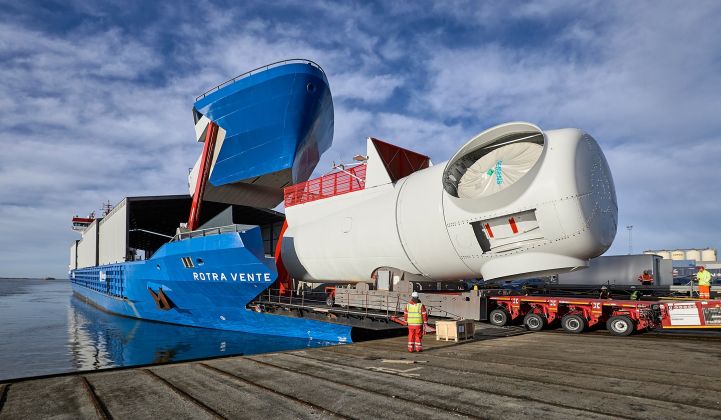Siemens Gamesa Renewable Energy, the world’s largest supplier of offshore wind turbines, won the order for Dominion Energy’s 2,640-megawatt project off the coast of Virginia, solidifying its leading role in the burgeoning U.S. offshore market.
The deal ranks not only among the largest offshore turbine orders in history, but also among the largest the global wind industry has ever seen. It will further bolster the case for investment into the essentially nonexistent U.S. offshore wind supply chain.
Virginia-based Dominion, a major U.S. investor-owned utility group, secured the development rights for a large zone nearly 30 miles off the coast of its home state back in 2013. But its 2.64-gigawatt offshore project, by far the largest currently on the drawing board in the U.S., has come together rapidly — with Dominion only laying out its full $7.8 billion plan last September.
Dominion plans to build its project in three 880-megawatt phases, completing one phase each year from 2024 to 2026. The wind farm will plug into PJM’s wholesale power market, and its cost will be borne by Dominion's ratepayers.
Dominion's speed reflects Virginia’s accelerating ambitions for renewable energy, with Governor Ralph Northam last fall announcing a 30 percent renewable electricity requirement for 2030, as well as the surge in optimism the U.S. offshore market has seen over the last few years. Dominion paid $1.6 million for its offshore zone in 2013; the last federal offshore wind lease area auction saw three zones go for $135 million apiece.
Siemens Gamesa said the exact turbine models and capacity ratings have not yet been decided upon. But Shashi Barla, Wood Mackenzie's principal analyst for the global wind supply chain and technology, said competition with other manufacturers — notably GE's 12-megawatt Haliade-X model — may have led Siemens Gamesa to offer its next-generation turbine, an upgrade of the current 11-megawatt platform.
"SGRE may have aggressively pitched the next-generation turbine to fend off the competitive threat from GE and MHI Vestas," Barla said. "The project commissioning timelines of 2024-2026 bode well for SGRE's turbine development timeframe," Barla added.
The turbine deal remains subject to Dominion’s final investment decision, governmental permitting — no sure thing given Vineyard Wind's ongoing uncertainty — and other approvals.
Dominion will begin construction work after completing a 12-megawatt pilot this year at a site adjacent to the full zone off Virginia Beach, using two 6-megawatt turbines from Siemens Gamesa. Dominion’s pilot, developed in collaboration with Ørsted, looks set to become the second U.S. offshore wind facility in operation.
Huge new market for offshore turbine suppliers
Although the U.S. has a mere 30 megawatts of installed offshore wind capacity today, it has emerged over the past year as a source of massive orders for the trio of leading offshore turbine suppliers outside of China: Siemens Gamesa, MHI Vestas and GE.
MHI Vestas was first out of the gate, winning an order in late 2018 to supply Vineyard Wind’s now-delayed 800-megawatt project south of Martha’s Vineyard with 9.5-megawatt turbines. Last fall, GE won a 1.2-gigawatt Haliade-X order from Ørsted for projects in New Jersey and Maryland.
But even before winning Dominion’s order, Siemens Gamesa stood at the front of the pack, having secured a 1.7-gigawatt order from Ørsted for a trio of projects, including its 880-megawatt Sunrise Wind development for New York state. The latest deal "catapults" Siemens Gamesa to a 4.3-gigawatt order backlog in the U.S., Barla said.
With the U.S. on track to install more than 19 gigawatts of offshore wind capacity by 2028, according to Wood Mackenzie, turbine manufacturers are under pressure to create a local supply chain, both for political reasons and ultimately to avoid the cost of transporting enormous pieces of equipment across the ocean.
While Siemens Gamesa owns onshore wind factories in Kansas and Iowa, the manufacturer — like rivals GE and MHI Vestas — will supply the nacelles and blades for its earliest U.S. offshore projects from Europe.
GE, which has two offshore factories in France and another on the way in China, has said that it’s “inevitable” that big offshore wind factories will come to U.S. soil, without yet making any commitments of its own. Ørsted, the world's leading offshore wind developer, is working with Germany's EEW to establish a factory for subsea foundations in New Jersey.
Spain-based Siemens Gamesa is the world’s second-leading wind turbine supplier overall, after Vestas. But it’s the established market leader in the offshore arena, accounting for more than half of global installations to date, far surpassing its closest rivals, MHI Vestas and China’s Sewind, according to WoodMac data.
Globally, WoodMac expects 128 gigawatts of offshore wind capacity to be built between 2020 and 2028. The U.S. is poised to become the second-largest offshore wind market globally by 2023, Barla noted.
Germany’s Siemens, which holds a 59 percent stake in Siemens Gamesa, plans to merge the wind manufacturer with its own struggling energy division, creating a new multitechnology energy giant that is set for an initial public offering later this year.




